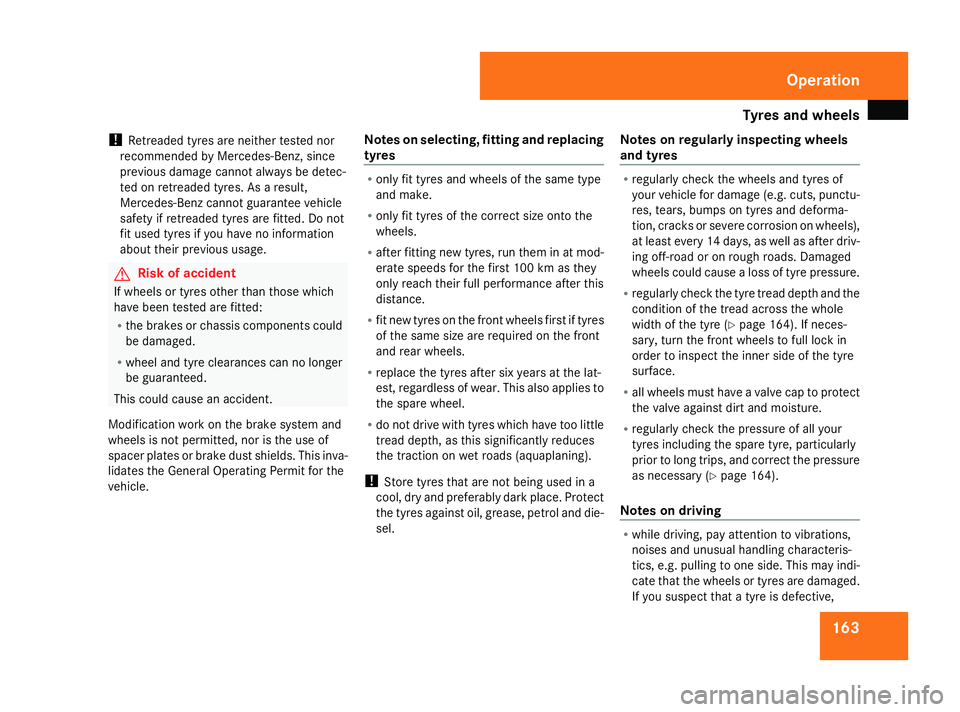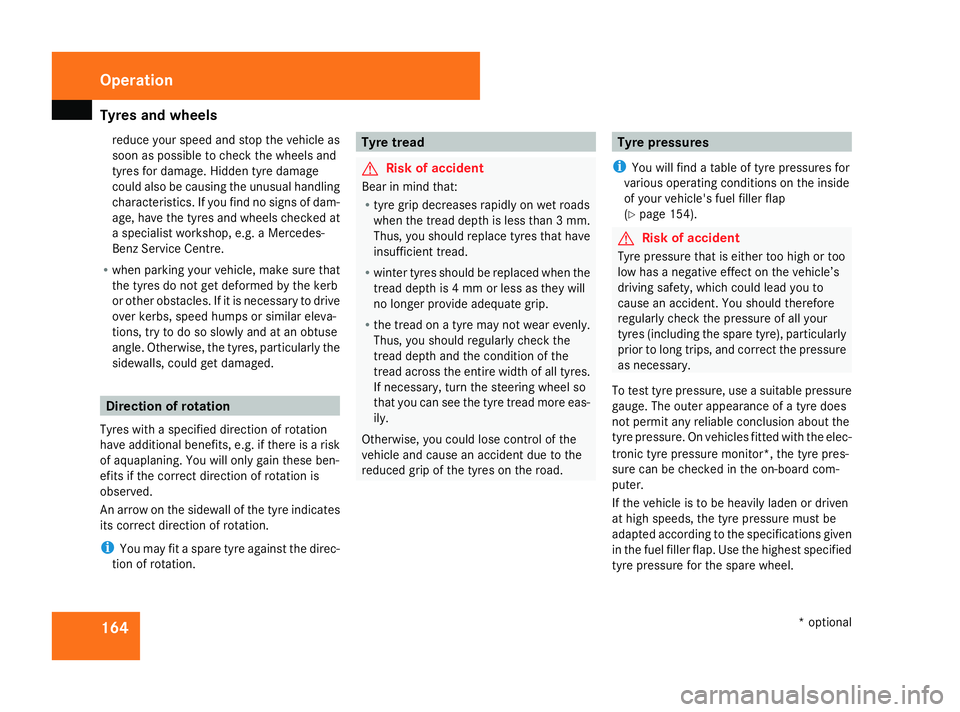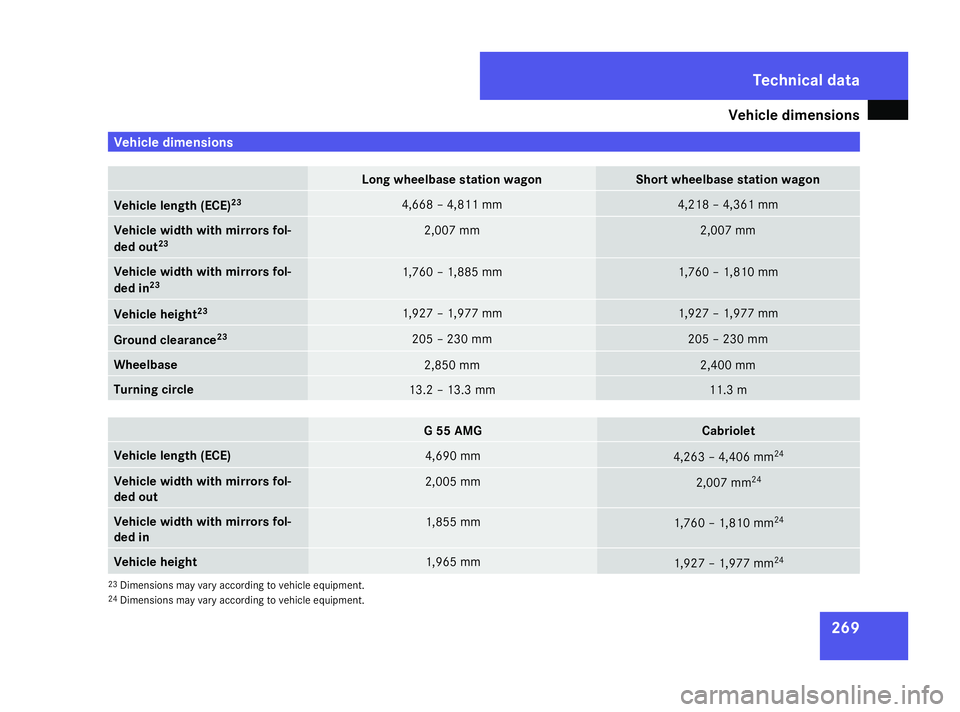width MERCEDES-BENZ G-CLASS SUV 2008 Owners Manual
[x] Cancel search | Manufacturer: MERCEDES-BENZ, Model Year: 2008, Model line: G-CLASS SUV, Model: MERCEDES-BENZ G-CLASS SUV 2008Pages: 293, PDF Size: 4.49 MB
Page 166 of 293

Tyres and wheels
163
!
Retreaded tyres are neither tested nor
recommended by Mercedes-Benz, since
previous damage cannot always be detec-
ted on retreaded tyres. As a result,
Mercedes-Benz cannot guarantee vehicle
safety if retreaded tyres are fitted. Do not
fit used tyres if you have no information
about their previous usage. G
Risk of accident
If wheels or tyres other than those which
have been tested are fitted:
R the brakes or chassis components could
be damaged.
R wheel and tyre clearances can no longer
be guaranteed.
This could cause an accident.
Modification work on the brake system and
wheels is not permitted, nor is the use of
spacer plates or brake dust shields. This inva-
lidates the General Operating Permit for the
vehicle. Notes on selecting, fitting and replacing
tyres R
only fit tyres and wheels of the same type
and make.
R only fit tyres of the correct size onto the
wheels.
R after fitting new tyres, run them in at mod-
erate speeds for the first 100 km as they
only reach their full performance after this
distance.
R fit new tyres on the front wheels first if tyres
of the same size are required on the front
and rear wheels.
R replace the tyres after six years at the lat-
est, regardless of wear. This also applies to
the spare wheel.
R do not drive with tyres which have too little
tread depth, as this significantly reduces
the traction on wet roads (aquaplaning).
! Store tyres that are not being used in a
cool, dry and preferably dark place. Protect
the tyres against oil, grease, petrol and die-
sel. Notes on regularly inspecting wheels
and tyres R
regularly check the wheels and tyres of
your vehicle for damage (e.g. cuts, punctu-
res, tears, bumps on tyres and deforma-
tion, cracks or severe corrosion on wheels),
at least every 14 days, as well as after driv-
ing off-road or on rough roads. Damaged
wheels could cause a loss of tyre pressure.
R regularly check the tyre tread depth and the
condition of the tread across the whole
width of the tyre (Y page 164). If neces-
sary, turn the front wheels to full lock in
order to inspect the inner side of the tyre
surface.
R all wheels must have a valve cap to protect
the valve against dirt and moisture.
R regularly check the pressure of all your
tyres including the spare tyre, particularly
prior to long trips, and correct the pressure
as necessary (Y page 164).
Notes on driving R
while driving, pay attention to vibrations,
noises and unusual handling characteris-
tics, e.g. pulling to one side. This may indi-
cate that the wheels or tyres are damaged.
If you suspect that a tyre is defective, Operation
463_AKB; 1; 8, en-GB
wobuchh
,V ersion: 2.10.6
2008-07-17T15:19:41+02:00 - Seite 163 ZDateiname: 6515_4091_02_buchblock.pdf; preflight
Page 167 of 293

Tyres and wheels
164reduce your speed and stop the vehicle as
soon as possible to check the wheels and
tyres for damage. Hidden tyre damage
could also be causing the unusual handling
characteristics. If you find no signs of dam-
age, have the tyres and wheels checked at
a specialist workshop, e.g. a Mercedes-
Benz Service Centre.
R when parking your vehicle, make sure that
the tyres do not get deformed by the kerb
or other obstacles. If it is necessary to drive
over kerbs, speed humps or similar eleva-
tions, try to do so slowly and at an obtuse
angle. Otherwise, the tyres, particularly the
sidewalls, could get damaged. Direction of rotation
Tyres with a specified direction of rotation
have additional benefits, e.g. if there is a risk
of aquaplaning. You will only gain these ben-
efits if the correct direction of rotation is
observed.
An arrow on the sidewall of the tyre indicates
its correct direction of rotation.
i You may fit a spare tyre against the direc-
tion of rotation. Tyr
e tread G
Risk of accident
Bear in mind that:
R tyre grip decreases rapidly on wet roads
when the tread depth is less than 3 mm.
Thus, you should replace tyres that have
insufficient tread.
R winter tyres should be replaced when the
tread depth is 4 mm or less as they will
no longer provide adequate grip.
R the tread on a tyre may not wear evenly.
Thus, you should regularly check the
tread depth and the condition of the
tread across the entire width of all tyres.
If necessary, turn the steering wheel so
that you can see the tyre tread more eas-
ily.
Otherwise, you could lose control of the
vehicle and cause an accident due to the
reduced grip of the tyres on the road. Tyre pressures
i You will find a table of tyre pressures for
various operating conditions on the inside
of your vehicle's fuel filler flap
(Y page 154). G
Risk of accident
Tyre pressure that is either too high or too
low has a negative effect on the vehicle’s
driving safety, which could lead you to
cause an accident. You should therefore
regularly check the pressure of all your
tyres (including the spare tyre), particularly
prior to long trips, and correct the pressure
as necessary.
To test tyre pressure, use a suitable pressure
gauge. The outer appearance of a tyre does
not permit any reliable conclusion about the
tyre pressure. On vehicles fitted with the elec-
tronic tyre pressure monitor*, the tyre pres-
sure can be checked in the on-board com-
puter.
If the vehicle is to be heavily laden or driven
at high speeds, the tyre pressure must be
adapted according to the specifications given
in the fuel filler flap. Use the highest specified
tyre pressure for the spare wheel. Operation
* optional
463_AKB; 1; 8, en-GB
wobuchh,
Version: 2.10.6 2008-07-17T15:19:41+02:00 - Seite 164Dateiname: 6515_4091_02_buchblock.pdf; preflight
Page 272 of 293

Vehicle dimensions
269Vehicle dimensions
Long wheelbase station wagon Short wheelbase station wagon
Vehicle length (ECE)
23 4,668 – 4,811 mm 4,218 – 4,361 mm
Vehicle width with mirrors fol-
ded out 23 2,007 mm 2,007 mm
Vehicle width with mirrors fol-
ded in 23 1,760 – 1,885 mm 1,760 – 1,810 mm
Vehicle height
23 1,927 – 1,977 mm 1,927 – 1,977 mm
Ground clearance
23 205 – 230 mm 205 – 230 mm
Wheelbase
2,850 mm 2,400 mm
Turning circle
13.2 – 13.3 mm 11.3 m
G 55 AMG Cabriolet
Vehicle length (ECE)
4,690 mm
4,263 – 4,406 mm
24 Vehicle width with mirrors fol-
ded out 2,005 mm
2,007 mm
24 Vehicle width with mirrors fol-
ded in 1,855 mm
1,760 – 1,810 mm
24 Vehicle height
1,965 mm
1,927 – 1,977 mm
24 23
Dimensions may vary according to vehicle equipment.
24 Dimensions may vary according to vehicle equipment. Te
chnical da ta
463_AKB; 1; 8, en-GB
wobuchh
,V ersion: 2.10.6
2008-07-17T15:19:41+02:00 - Seite 269 ZDateiname: 6515_4091_02_buchblock.pdf; preflight